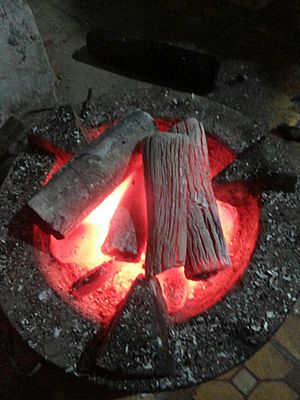Calorific value facts for kids

The calorific value of a substance tells us how much energy is released as heat when a certain amount of that substance burns. Think of it as measuring how much "power" a fuel has when it's burned. This energy is released under specific, standard conditions. You might also hear it called the heat of combustion or energy value. It's super important for understanding fuels and how much heat they can produce.
Contents
What is Calorific Value?
Calorific value measures the total heat energy given off when a substance burns completely. This burning process is called combustion. When something burns, it reacts with oxygen and releases energy. This energy often comes out as heat and light.
Why is it Important?
Knowing the calorific value helps us understand how efficient a fuel is. For example, engineers use it to design engines and power plants. Cooks might think about it when choosing fuels for cooking. It helps us pick the best fuels for different jobs, from heating homes to launching rockets.
Fuels and Energy
Different fuels have different calorific values. Fuels like natural gas, petrol, and coal are used because they release a lot of heat energy when burned. This energy can then be used to do work, like moving a car or generating electricity.
How is Calorific Value Measured?
Scientists usually measure calorific value using a special device called a bomb calorimeter.
The Bomb Calorimeter
A bomb calorimeter is a sealed container where a small amount of the substance is burned. The container is surrounded by water. When the substance burns, the heat released warms up the water. By measuring how much the water's temperature rises, scientists can calculate the amount of heat energy produced.
Units of Measurement
Calorific value is often measured in:
- Joules per kilogram (J/kg) or kilojoules per kilogram (kJ/kg) in the SI system.
- Calories per gram (cal/g) or kilocalories per kilogram (kcal/kg).
- British thermal units per pound (BTU/lb) in the imperial system.
Types of Calorific Value
There are two main types of calorific value:
Gross Calorific Value (GCV)
The Gross Calorific Value (GCV), also known as Higher Heating Value (HHV), includes all the heat released. This includes the heat from the water vapor that forms during burning. If this water vapor cools down and turns back into liquid water, it releases even more heat. GCV counts this extra heat.
Net Calorific Value (NCV)
The Net Calorific Value (NCV), also known as Lower Heating Value (LHV), does not include the heat from the water vapor. It assumes the water vapor stays as a gas and doesn't condense. NCV is often more practical for real-world applications because in many engines, the water vapor escapes as steam and doesn't give off its extra heat.
Examples of Calorific Values
Different substances have very different calorific values. Here are a few examples:
- Hydrogen gas: Has a very high calorific value, making it a powerful fuel.
- Natural gas: A common fuel for heating and electricity generation.
- Petrol (Gasoline): Used in cars and other vehicles.
- Coal: A fossil fuel used in power plants.
- Wood: A traditional fuel, but with a lower calorific value than fossil fuels.
Understanding calorific value helps us make smart choices about energy and fuels. It's a key concept in chemistry, physics, and engineering.
See also
 In Spanish: Poder calorífico para niños
In Spanish: Poder calorífico para niños

